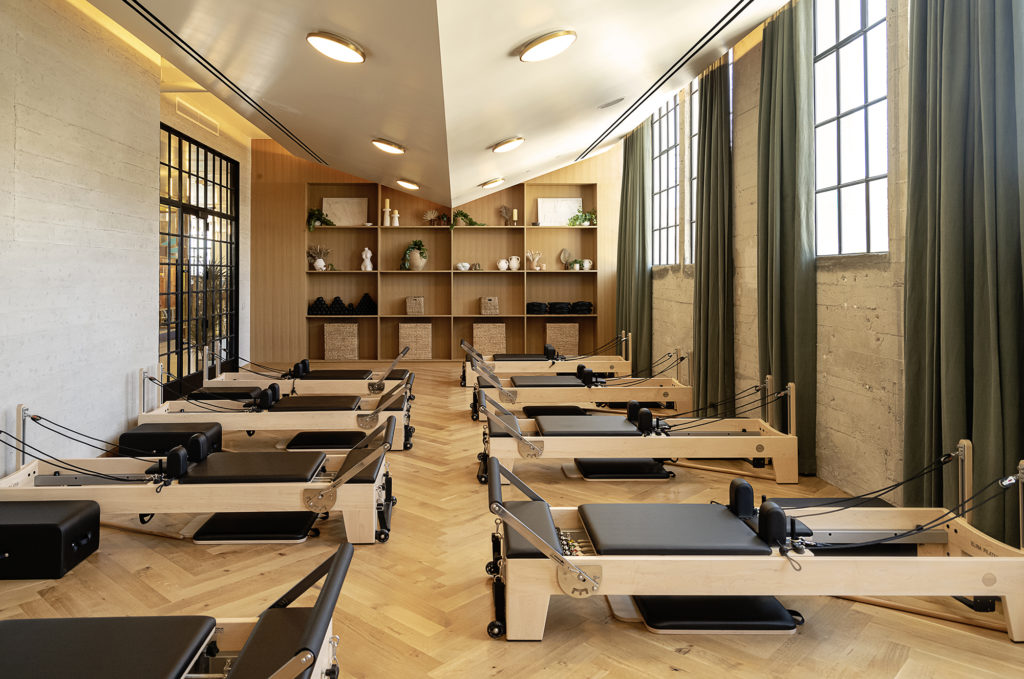Whether you’re new to Pilates or want to explore beyond your current practice, there’s a Pilates style for every kind of mover. Trending more than ever as one of the best wellness practices right now, many people are transitioning away from their heavy weighted gym routines to this low-impact and toning workout. And no, it’s not just for social media influencers and the aesthetic—with so many variations like mat, reformer, classical, contemporary, and clinical—Pilates is helping people of all ages with full body strength and flexibility. Here’s how to find the style that fits your body and your fitness goals.
Mat Pilates
Mat Pilates is the easiest way to get into Pilates—no machines required. The workouts are popular for solo or group classes, and are ideal for Pilates learners of all-levels. While all that’s required is yourself and your mat, many classes incorporate specialized equipment like a magic circle, resistance band, foam roller, ankle/arm weights, exercise balls, and floor sliders. Unlike yoga, mat Pilates is less flow-based but aims more to utilize low-weighted movements to target your core to build strength, stability, and flexibility. Studios across the West offer routines from heated classes, to muscle specific or HIIT-inspired workouts. If you are looking to start in Pilates, mat Pilates is a great way to build foundational strength and master the basics.
Courtesy of Alo Yoga
Reformer Pilates

Courtesy of HEIMAT
Reformer Pilates uses a spring-loaded machine that looks intimidating at first—but trust me, it’s not. The reformer adds resistance to traditional Pilates movements with sliding carriage, pulleys, and adjustable springs that allow you to control the level of resistance best fit for you. Reformer is one of the most trending workouts right now and with the right instructor, it is easy to learn. The reformer supports precise alignment and deep muscle engagement, making it practical for strength training, flexibility, and rehabilitation. While many studios offer reformer classes for all levels, taking mat classes first can help you build the foundational control needed for reformer work. With proper form and technique, reformer Pilates delivers a powerful and satisfying full-body burn. Pro-tip: Be sure to grab a pair of Pilates grip socks—they help prevent slipping on the reformer and are often required.

Courtesy of Lululemon
Classical Pilates
Incorporating traditional Pilates movements, classical Pilates follows the original methods of Joseph Pilates from the early 20th century. The German-American physical trainer invented the classical Pilates movements, giving the practice the foundation it has today. With focus on clarity within your mind, body, and spirit, classical Pilates is based upon six principles: breath, concentration, centering, control, precision, and flow. The sequence of movements aim to work together and provide exercises that align the spine and strengthen the core. The practice prioritizes slow, structured, and dynamic flowing movements, similar to the holistic approach of yoga. Classical Pilates is structured, intentional, and ideal for those who want a disciplined approach grounded in tradition.
Contemporary Pilates
Contemporary Pilates blends traditional Pilates principles with modern movement practices like yoga, physiotherapy, and dance—making it a more creative and less traditional approach. It is becoming more and more popular today—especially among the younger generation and those seeking variety. Equipment use can range from reformers to small props, and many studios today incorporate dance, pop music, and faster pace workouts into the routine. If you’re looking for a more dynamic, adaptable, and personalized Pilates approach, contemporary is likely your match.
Clinical Pilates
Clinical Pilates incorporates the slow and controlled nature of classical Pilates movements, making it one of the most useful rehabilitative exercises for those addressing specific injuries or imbalances. Studios across the West offer individual or small group clinical sessions with certified instructors and physiotherapists. This approach is tailored to individual needs and conditions—especially good for back and neck pain. While common among older adults or post-injury clients, clinical Pilates benefits anyone seeking a safe, personalized, low-impact way to target their muscles and recover function.
We only recommend things we love. If you buy something through our site, we might earn a commission.


